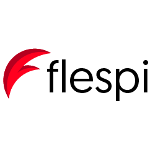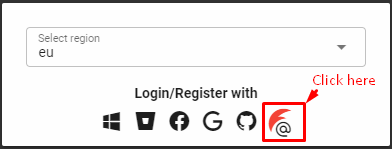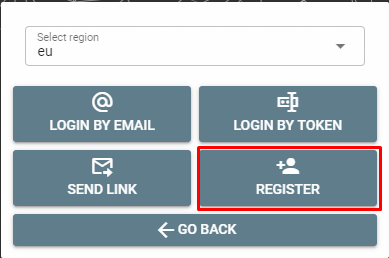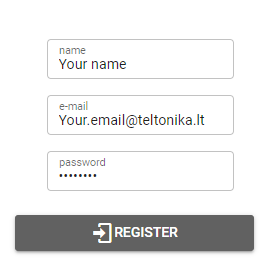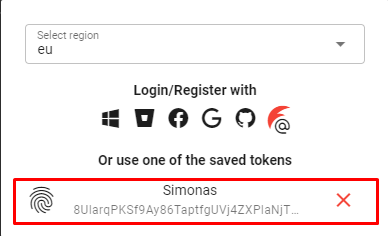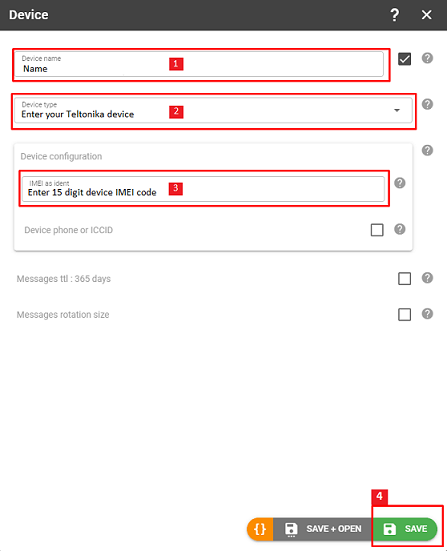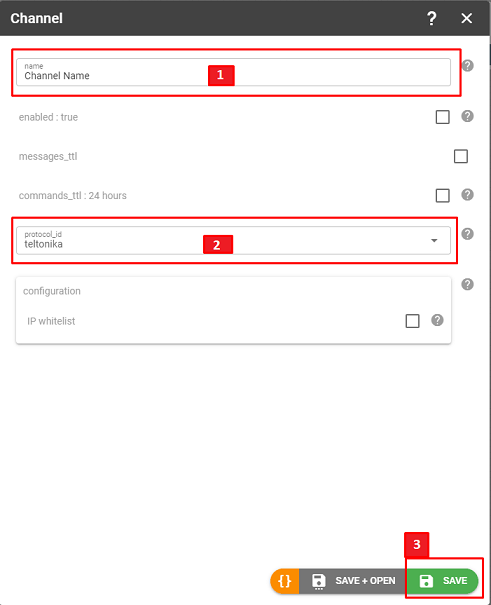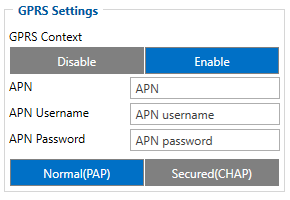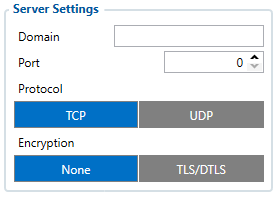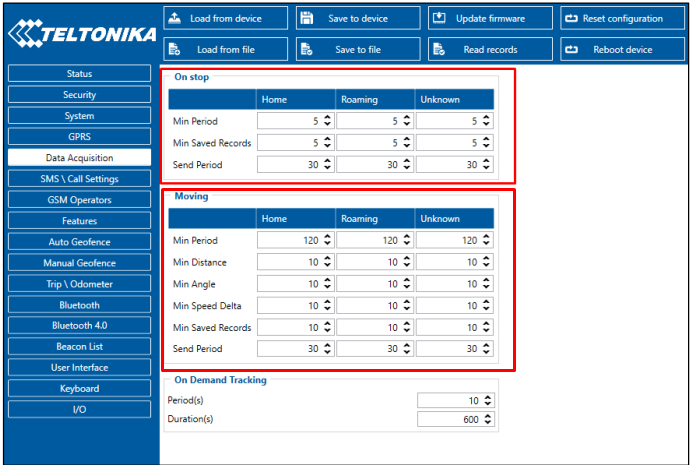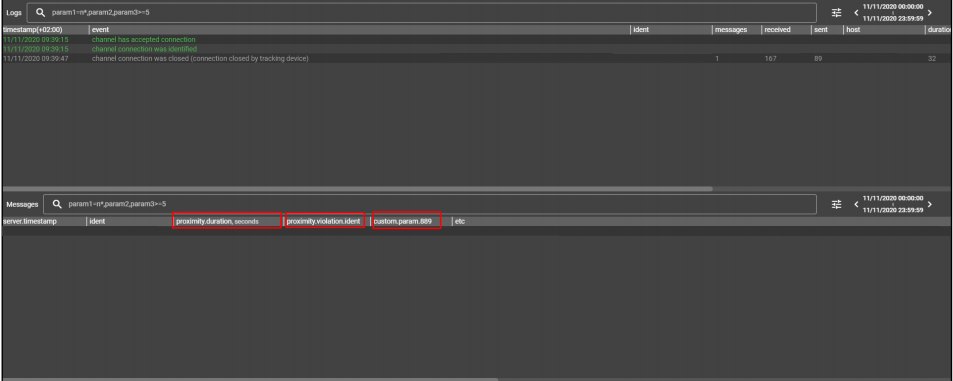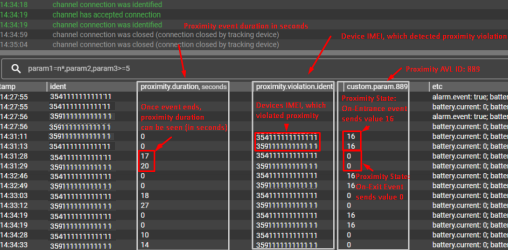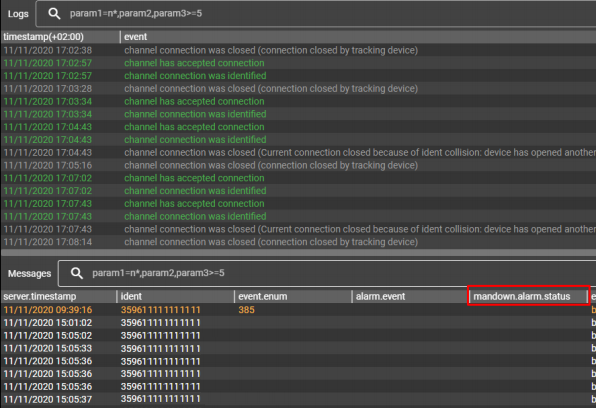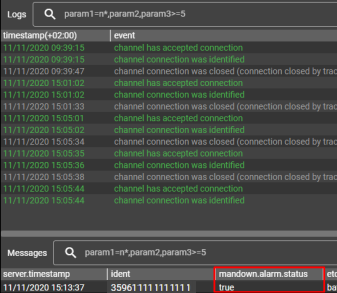Difference between revisions of "Flespi with Fleet Management (FM)"
m |
|||
| (3 intermediate revisions by the same user not shown) | |||
| Line 1: | Line 1: | ||
| − | [[Image: | + | ==Introduction== |
| − | < | + | [[Image:Flespi.png|300px|frame]] |
| + | Many clients who own a Teltonika device ask how to create a server to send data to. To get you a quick start, we present you a tutorial with the most important steps that have to be taken, when setting up your device to send data to the server – flespi platform! | ||
| + | <br><br><br><br><br><br> | ||
| − | == | + | ==First time with flespi== |
| − | + | <b>1.</b> Go to [https://flespi.io/ flespi.io]<br> | |
| + | <b>2.</b> Click on <b>Login/Register</b> button<br> | ||
| + | <b>3.</b> Click on one of the icons to register with<br> | ||
| − | + | <i>In the example, registering is done as shown in the picture:</i> | |
| + | [[Image:Flespi_register.png|1000px|frame|center]]<br> | ||
| − | + | <b>4.</b> After clicking the ‘<b>@</b>’ icon, click the <b>REGISTER</b> button<br> | |
| − | |||
| − | |||
| − | |||
| − | + | [[Image:Flespi_register1.png|1000px|frame|center]]<br> | |
| − | + | <b>5.</b> Fill the required fields in order to register<br> | |
| − | |||
| − | |||
| − | + | [[Image:Flespi_register2.png|1000px|frame|center]]<br> | |
| + | |||
| + | <b>NOTE:</b> When logging in the first time, a platform generates a <i>MASTER FLESPI TOKEN</i>, therefore you | ||
| + | will not be required to use a password, when logging into the platform next time. To login next | ||
| + | time, simply to press the fingerprint icon, visual example is shown below<br> | ||
| + | |||
| + | [[Image:Flespi_login.png|1000px|frame|center]]<br> | ||
| + | |||
| + | ==How to add a device== | ||
| + | |||
| + | <b>1.</b> Click on <b>Telematics Hub</b> to expand the panel<br> | ||
| + | <b>2.</b> Click <b>Devices tab</b><br> | ||
| + | <b>3.</b> To add a device, click '<b>+</b>' button, which is at the bottom right corner of the screen<br> | ||
| + | <b>4.</b> After '<b>+</b>' clicking button, a Device tab appears in which you have to fill the fields<br> | ||
| + | |||
| + | [[Image:Device_add.png|1000px|frame|center]]<br> | ||
| + | |||
| + | <b>5.</b> Once saved, a created device in device tab appears<br> | ||
| + | |||
| + | [[Image:Example_device_tab.png|1000px|frame|center]]<br> | ||
| + | |||
| + | ==How to create a channel== | ||
| + | |||
| + | <b>1.</b> Click on <b>Telematics Hub</b> to expand the panel<br> | ||
| + | <b>2.</b> Click <b>Channels tab</b><br> | ||
| + | <b>3.</b> To add a channel, click '<b>+</b>' button, which is at the bottom right corner of the screen<br> | ||
| + | <b>4.</b> After '<b>+</b>' clicking button, a Channel tab appears in which you have to fill the following fields<br> | ||
| + | |||
| + | [[Image:Example_Channel_add.png|1000px|frame|center]]<br> | ||
| + | |||
| + | <b>5.</b> Once the saving is done, a channel is created. In example below, a channel named TELTONIKA_TEST is created<br> | ||
| + | <br> | ||
| + | [[Image:Channel_domain-port.png|1000px|frame|center]]<br> | ||
| + | |||
| + | ==How to connect a device to created channel== | ||
| + | In instructions [[First_time_with_flespi_platform#How_to_create_a_Channel| <i>'How to create a channel'</i>]] a channel has been created with channel <b>IP Address/Domain and Port</b> numbers. To connect to that | ||
| + | channel, the device must be configured. <b>IP Address/Domain and Port</b> numbers are shown in image below.<br> | ||
| + | <br> | ||
| + | [[Image:Channel_domain-port.png|1000px|frame|center]]<br> | ||
| + | |||
| + | <b>Teltonika configurator: Setting up a device for communication with the server</b> | ||
| + | {|style="width: 100%;" | ||
| + | |[[Image:GPRS_settings.png|right]] | ||
| + | <b>1.</b> Press <b>GPRS</b> tab<br> | ||
| + | * <b>''GPRS Context'' field requires you to enter your SIM providers' APN settings. Make sure to fill this in based on the SIM provider you are using with your Teltonika device.</b> | ||
| + | More information about ''GPRS'' panel and it's parameters for each device can be found here: | ||
| + | |||
| + | [[TST100 GPRS settings|TST100]] | [[TFT100 GPRS settings|TFT100]] | [[GH5200 GPRS settings|GH5200]] | [[TMT250 GPRS settings|TMT250]] | ||
| + | |} | ||
| + | |||
| + | {|style="width: 100%;" | ||
| + | |[[Image:Server_settings.png|right]] | ||
| + | <b>2.</b> In <b>GPRS</b>-><b>Server settings</b> -> <b>Domain</b> field, enter <b>flespi domain</b><br> | ||
| + | <b>3.</b> In <b>Port</b> field, enter <b>flespi domain port</b> number<br> | ||
| + | |} | ||
| + | |||
| + | <b>Note:</b> To configure how frequently the device sends data to the <i>flespi</i> platform, go to <b>Data Acquisition settings</b> | ||
| + | and set <b>On stop</b>, <b>Moving</b> parameters in the configurator. In the example below, the device has been | ||
| + | configured to:<br> | ||
| + | * <i>Min Period</i> – Acquire a new record every 5 seconds <br> | ||
| + | * <i>Min Saved Records </i> – Have minimum 5 records in one data packet that can be sent to the server<br> | ||
| + | * <i>Send Period</i> – Send records to the server every 30 seconds.<br> | ||
| + | |||
| + | More information about ''Data acquisition'' panel for each device can be found here: | ||
| + | |||
| + | [[TST100_Data_acquisition_settings|TST100]] | [[TFT100_Data_acquisition_settings|TFT100]] | [[GH5200_Data_acquisition_settings|GH5200]] | [[TMT250_Data_acquisition_settings|TMT250]] | ||
| + | |||
| + | |||
| + | <br> | ||
| + | [[Image:Data_acquisition_flespi.png|1000px|frame|center]]<br> | ||
| + | |||
| + | ==Tracking proximity records on flespi== | ||
| + | Before going any further, make sure you have configured proximity settings!<br> | ||
| + | |||
| + | * <b>To find out more about proximity feature visit:</b> [[Proximity|About proximity]] | ||
| + | * <b>To start a Proximity Quick Start Guide visit:</b> [[Proximity functionality Quick Start Guide|Proximity functionality Quick Start Guide]]<br> | ||
| + | <br> | ||
| + | <div style="text-align: center;">[[File:Alert.png|30px]]</div> | ||
| + | <div style="text-align: center;"><b>To use proximity feature or track proximity records, device proximity firmware is required!</b></div> | ||
| + | <div style="text-align: center;"><b>We recommend to use the latest version of the firmware. Contact your sales manager to get Teltonika Drive link and download the latest version.</b></div><br> | ||
| + | |||
| + | <b>1.</b> Go to [https://flespi.io/ flespi.io] platform<br> | ||
| + | <b>2.</b> Login and select <b>Channels</b> panel<br> | ||
| + | <b>3.</b> Tap on a <b>channel</b><br> | ||
| + | <b>4.</b> When selected, a channel window appears. Click on <b>TOOLBOX</b></b><br> | ||
| + | <b>5.</b> When <b>TOOLBOX</b></b> is opened, a new screen appears, where records from the device sent to the channel can be seen<br> | ||
| + | <b>6.</b> Click on icon, which is at the bottom right side as shown in the picture below<br> | ||
| + | |||
| + | [[Image:Server_icons.png|1000px|frame|center]]<br> | ||
| + | |||
| + | <b>7.</b> In the search field, search for these parameters:<br> | ||
| + | * proximity.duration<br> | ||
| + | * proximity.violation.ident<br> | ||
| + | * custom.param.889<br> | ||
| + | <b>Click on the eye button to add each of the searched columns</b><br> | ||
| + | |||
| + | <b>8.</b> If everything is done correctly, at the bottom, three new recently added columns are visible<br> | ||
| + | |||
| + | [[Image:New_columns_flespi.png|1000px|frame|center]]<br> | ||
| + | |||
| + | <b>9.</b> Now unplug the devices and test proximity feature. When proximity event happens, the device sends data to the flespi platform.<br> | ||
| + | |||
| + | [[Image:Proximity_flespi_violation.png|1000px|frame|center]]<br> | ||
| + | |||
| + | <div style="text-align: center;"><b>Information about parameters:</b></div> | ||
| + | {| class="wikitable" style="margin: 1em auto;" | ||
| + | |||
| + | |- | ||
| + | | <b>Column name</b> | ||
| + | | <b>Description</b> | ||
| + | |- | ||
| + | | proximity.duration || Time period proximity event has happened in seconds | ||
| + | |- | ||
| + | | proximity.violation.ident || IMEI number of devices that have violated the personal space. | ||
| + | |- | ||
| + | | custom.param.889 || AVL ID – 889 Shows proximity state: <b>On-Entrace</b> event sends value – 16, <b>On-Exit</b> event sends value – 0 | ||
| + | |- | ||
| + | |} | ||
| + | |||
| + | ==Tracking ManDown records on flespi== | ||
| + | * <b>To find out about ManDown feature visit:</b> [[GH5200_Features_settings#ManDown|GH5200]] | [[TMT250_Features_settings#ManDown|TMT250]] | ||
| + | * <b>To learn how to configure a ManDown feature visit:</b> [[How_to_configure_ManDown_scenario|ManDown scenario]]<br> | ||
| + | <b>1.</b> Go to [https://flespi.io/ flespi.io] platform<br> | ||
| + | <b>2.</b> Login and select <b>Channels</b> panel<br> | ||
| + | <b>3.</b> Tap on a <b>channel</b><br> | ||
| + | <b>4.</b> When selected, a channel window appears. Click on <b>TOOLBOX</b></b><br> | ||
| + | <b>5.</b> When <b>TOOLBOX</b></b> is opened, a new screen appears, where records from the device sent to the channel can be seen<br> | ||
| + | <b>6.</b> Click on icon, which is at the bottom right side as shown in the picture below<br> | ||
| + | |||
| + | [[Image:Server_icons.png|1000px|frame|center]]<br> | ||
| + | |||
| + | <b>7.</b> In the search field, search for <b>mandown.alarm.status</b> parameter<br> | ||
| + | <b>Click on the eye button to add a column</b><br> | ||
| + | <b>8.</b> If everything is done correctly, at the bottom, a new recently added column is visible: <b>mandown.alarm.status</b> | ||
| + | |||
| + | [[Image:ManDown_flespi.png|1000px|frame|center]]<br> | ||
| + | |||
| + | <b>9.</b> When a ManDown event happens, the device sends a record to flespi platform</b><br> | ||
| + | |||
| + | [[Image:Mandown_flespi_true.png|1000px|frame|center]]<br> | ||
| + | |||
| + | ==In door tracking using BLE advertising Beacons on flespi== | ||
| + | <br> | ||
| + | <div style="text-align: center;">[[File:Alert.png|30px]]</div> | ||
| + | <div style="text-align: center;"><b>Before going any further be sure that your Beacon is enabled and ready for configuration!</b></div><br> | ||
| + | |||
| + | <b>To learn how to configure in door tracking using BLE advertising Beacons visit:</b> [[How to read data from BLE Beacons]] | ||
| + | |||
| + | <b>1.</b> Go to [https://flespi.io/ flespi.io] platform<br> | ||
| + | <b>2.</b> Login and select <b>Channels</b> panel<br> | ||
| + | <b>3.</b> Tap on a <b>channel</b><br> | ||
| + | <b>4.</b> When selected, a channel window appears. Click on <b>TOOLBOX</b></b><br> | ||
| + | <b>5.</b> When <b>TOOLBOX</b></b> is opened, a new screen appears, where records from the device sent to the channel can be seen<br> | ||
| + | <b>6.</b> Click on icon, which is at the bottom right side as shown in the picture below<br> | ||
| + | |||
| + | [[Image:Server_icons.png|1000px|frame|center]]<br> | ||
| + | |||
| + | <b>7.</b> In the search field, search for <b>ble.beacons</b> parameter<br> | ||
| + | <b>Click on the eye button to add a column</b><br> | ||
| + | |||
| + | [[Image:BLE_BEACONS_FLESPI.png|1000px|frame|center]]<br> | ||
| + | |||
| + | <b>8.</b> If everything is done correctly, at the bottom, a new recently added column is visible: <b>ble.beacons</b> | ||
| + | |||
| + | [[Image:Blebeacons_column.png|1000px|frame|center]]<br> | ||
| + | |||
| + | <b>9.</b> Beacon data is sent to flespi platform, where beacon UUID can be seen and its radio signal strength | ||
| + | |||
| + | [[Image:Ble_beacon_packet.png|1000px|frame|center]]<br> | ||
| − | |||
[[Category: Fleet Management platforms]] | [[Category: Fleet Management platforms]] | ||
Revision as of 08:00, 21 April 2023
Main Page > General Information > Fleet Management platforms > Flespi with Fleet Management (FM)Introduction
Many clients who own a Teltonika device ask how to create a server to send data to. To get you a quick start, we present you a tutorial with the most important steps that have to be taken, when setting up your device to send data to the server – flespi platform!
First time with flespi
1. Go to flespi.io
2. Click on Login/Register button
3. Click on one of the icons to register with
In the example, registering is done as shown in the picture:
4. After clicking the ‘@’ icon, click the REGISTER button
5. Fill the required fields in order to register
NOTE: When logging in the first time, a platform generates a MASTER FLESPI TOKEN, therefore you
will not be required to use a password, when logging into the platform next time. To login next
time, simply to press the fingerprint icon, visual example is shown below
How to add a device
1. Click on Telematics Hub to expand the panel
2. Click Devices tab
3. To add a device, click '+' button, which is at the bottom right corner of the screen
4. After '+' clicking button, a Device tab appears in which you have to fill the fields
5. Once saved, a created device in device tab appears
How to create a channel
1. Click on Telematics Hub to expand the panel
2. Click Channels tab
3. To add a channel, click '+' button, which is at the bottom right corner of the screen
4. After '+' clicking button, a Channel tab appears in which you have to fill the following fields
5. Once the saving is done, a channel is created. In example below, a channel named TELTONIKA_TEST is created
How to connect a device to created channel
In instructions 'How to create a channel' a channel has been created with channel IP Address/Domain and Port numbers. To connect to that
channel, the device must be configured. IP Address/Domain and Port numbers are shown in image below.
Teltonika configurator: Setting up a device for communication with the server
|
1. Press GPRS tab
More information about GPRS panel and it's parameters for each device can be found here: |
|
2. In GPRS->Server settings -> Domain field, enter flespi domain |
Note: To configure how frequently the device sends data to the flespi platform, go to Data Acquisition settings
and set On stop, Moving parameters in the configurator. In the example below, the device has been
configured to:
- Min Period – Acquire a new record every 5 seconds
- Min Saved Records – Have minimum 5 records in one data packet that can be sent to the server
- Send Period – Send records to the server every 30 seconds.
More information about Data acquisition panel for each device can be found here:
TST100 | TFT100 | GH5200 | TMT250
Tracking proximity records on flespi
Before going any further, make sure you have configured proximity settings!
- To find out more about proximity feature visit: About proximity
- To start a Proximity Quick Start Guide visit: Proximity functionality Quick Start Guide
1. Go to flespi.io platform
2. Login and select Channels panel
3. Tap on a channel
4. When selected, a channel window appears. Click on TOOLBOX
5. When TOOLBOX is opened, a new screen appears, where records from the device sent to the channel can be seen
6. Click on icon, which is at the bottom right side as shown in the picture below
7. In the search field, search for these parameters:
- proximity.duration
- proximity.violation.ident
- custom.param.889
Click on the eye button to add each of the searched columns
8. If everything is done correctly, at the bottom, three new recently added columns are visible
9. Now unplug the devices and test proximity feature. When proximity event happens, the device sends data to the flespi platform.
| Column name | Description |
| proximity.duration | Time period proximity event has happened in seconds |
| proximity.violation.ident | IMEI number of devices that have violated the personal space. |
| custom.param.889 | AVL ID – 889 Shows proximity state: On-Entrace event sends value – 16, On-Exit event sends value – 0 |
Tracking ManDown records on flespi
- To find out about ManDown feature visit: GH5200 | TMT250
- To learn how to configure a ManDown feature visit: ManDown scenario
1. Go to flespi.io platform
2. Login and select Channels panel
3. Tap on a channel
4. When selected, a channel window appears. Click on TOOLBOX
5. When TOOLBOX is opened, a new screen appears, where records from the device sent to the channel can be seen
6. Click on icon, which is at the bottom right side as shown in the picture below
7. In the search field, search for mandown.alarm.status parameter
Click on the eye button to add a column
8. If everything is done correctly, at the bottom, a new recently added column is visible: mandown.alarm.status
9. When a ManDown event happens, the device sends a record to flespi platform
In door tracking using BLE advertising Beacons on flespi
To learn how to configure in door tracking using BLE advertising Beacons visit: How to read data from BLE Beacons
1. Go to flespi.io platform
2. Login and select Channels panel
3. Tap on a channel
4. When selected, a channel window appears. Click on TOOLBOX
5. When TOOLBOX is opened, a new screen appears, where records from the device sent to the channel can be seen
6. Click on icon, which is at the bottom right side as shown in the picture below
7. In the search field, search for ble.beacons parameter
Click on the eye button to add a column
8. If everything is done correctly, at the bottom, a new recently added column is visible: ble.beacons
9. Beacon data is sent to flespi platform, where beacon UUID can be seen and its radio signal strength
